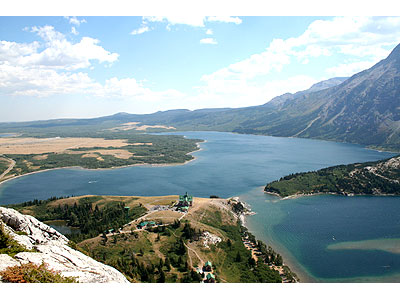A waterway is any navigable body of water, including rivers, lakes, oceans, and canals. In order for it to be navigable, it must meet several criteria:
- it has to be deep enough to allow the draft depth of the vessels using it;
- the waterway must be wide enough to allow passage for the beam width of the vessels using it;
- it has to be free of barriers to navigation such as waterfalls and rapids, or have a way around them (such as canal locks);
- the current of the waterway must be mild enough to allow vessels to make headway.

The world’s longest inland waterway open to ocean shipping is the St. Lawrence Seaway-Great Lakes Waterway in Canada, which was opened in 1959. It is 3,790 km in length, from Anticosti Island to the head of Lake Superior.
Almost 70% of United States’ agricultural exports travel the upper Mississippi River and the Illinois Waterway system.
Common waterway modifications – such as the construction of dams and irrigation channels, inter-basin connections and water transfers – can impact on the hydrology of freshwater systems, disconnect rivers from floodplains and wetlands, and decrease water velocity in riverine systems. This, in turn, can affect the seasonal flow and sediment transport of rivers downstream, impacting on fish migrations and changing the composition of riparian ecosystems. Exotic species often thrive at the expense of indigenous ones, leading to an unquantifiable loss in freshwater biodiversity and inland fishery resources.
Founded in the 5th century and spread over 118 small islands, within a lagoon formed by the River Po, the city of Venice in Italy, became a major maritime power in the 10th century. After the 9th century, the city developed as a port, becoming the most important centre for Levantine goods to enter Europe. The unique advantage of this city, was its harbour location at the intersection of the Occident (western Europe) and the Orient (the Middle East and Asia Minor). Throughout the Middle Ages, Venetian merchants held a monopoly on the riches coming from the Orient, and the city was able to develop into an empire.
Xochimilco, in Mexico, is the only reminder of the lakes that abounded in the Aztec capital, ‘the Venice of the New World.’ With its network of canals and artificial islands, it testifies to the efforts of the Aztec people to build a habitat in an unfavourable environment. This half natural, half artificial landscape is now an ecological reserve that covers 1,138 hectares.
The Panama Canal is a major shipping canal that cuts through the Isthmus of Panama in Central America, connecting the Atlantic and Pacific Oceans. The construction of the canal was one of the largest and most difficult engineering projects ever undertaken; it has had an enormous impact on shipping, because it removes the need for ships to travel the long and treacherous route via the Drake Passage and Cape Horn at the southernmost tip of South America. Although the concept of a canal in Panama dates back to the early 1500s, the first attempt to construct a canal began in 1880, under French leadership. This attempt collapsed, and the work was finally completed by the United States; the canal opened in 1914. The building of the 77 km canal was plagued by problems, including disease (particularly malaria and yellow fever) and massive landslides. As many as 22,000 workers are estimated to have died during construction of the canal. Each year, the canal accommodates the passage of over 14,000 ships, carrying over 203 million tonnes of cargo.
Information from:
the World Heritage Centre website
Problems related to freshwater resources section of the Vital Water Graphics website
Nile Basin Initiative (NBI) website
Source: UNESCO Water Portal, February 2006

